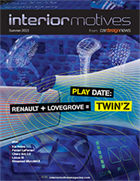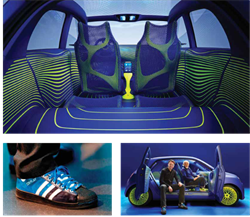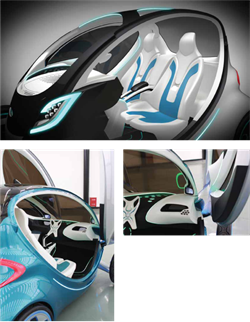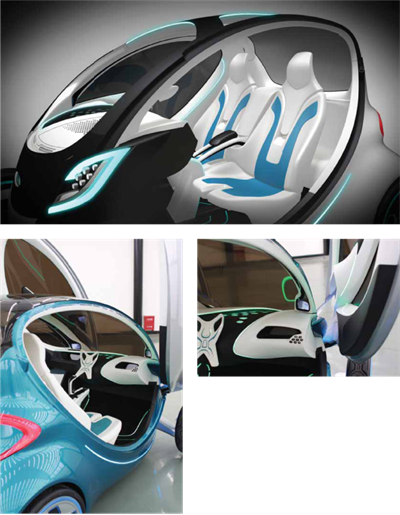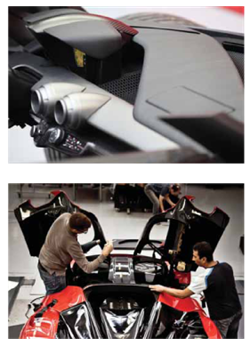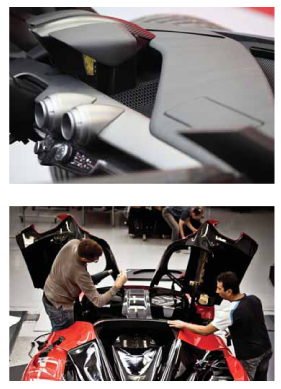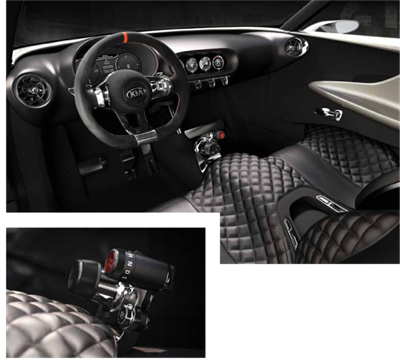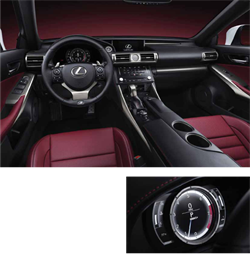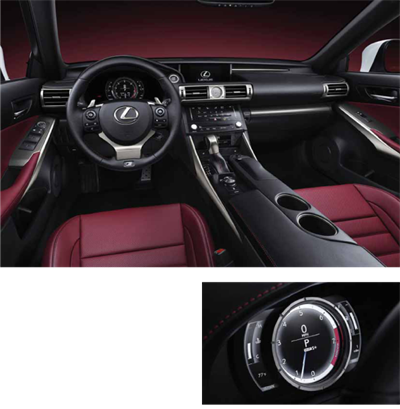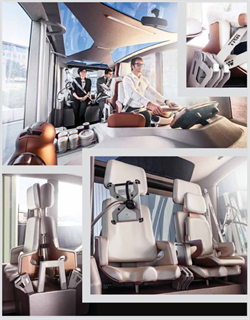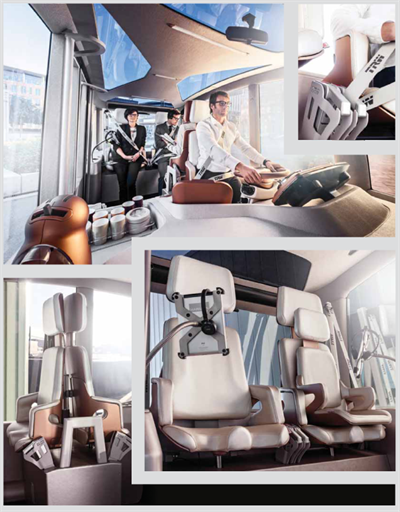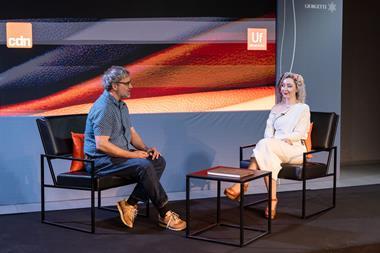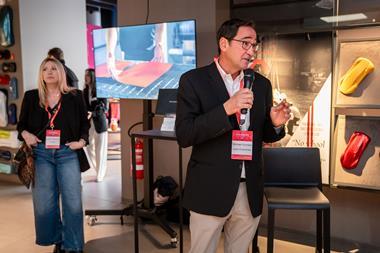IN THIS ISSUE
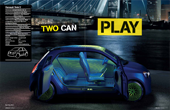 Vehicle type concept/electric city car
Vehicle type concept/electric city carDesign director Laurens van den Acker
Project leaders Anthony Lo, Axel Breun & Ross Lovegrove
Project manager Philippe Ponceau
Interior designers Ross Lovegrove, Matt Longbottom, Christopher Hermann (Lovegrove Studio)
Colour & trim designer Nathalie Granger
Technical project manager Minh Au Truong
Project started January 2012
Project completed April 2013
Launch Milan Design Week/April 2013
British product designer Ross Lovegrove’s involvement with the Twin’Z project – the fi fth of Renault design director Laurens van den Acker’s ‘Lifecycle’ series, themed ‘Play’– came about as a result of his consultancy work with Renault during the spring of 2012. “Renault was looking for some fresh blood, and we had developed such a good working relationship with their team [during the consultancy] that it made sense to continue [with the Twin’Z],” says Lovegrove. “The internal [Renault] team had worked on an interior for a few months, and Laurens [van den Acker] said to me: ‘What do you think?’ I was frank and quite unforgiving – not to get a job – and said, ‘this doesn’t really take you anywhere’. Then Laurens asked me what we [Lovegrove Studio] would do.”
 Vehicle type concept/electric city car
Vehicle type concept/electric city carCorporate design director, Chery James Hope
Design director Hakan Saracoglu
Chief designer Sergio Loureiro
Chief engineer Chen Jun
Information analyst Wang Jinghua
Project started October 2012
Project completed April 2013
Launch Shanghai/April 2013
The Ant 2.0 concept that appeared at Shanghai in April follows in the footsteps of the original 2012 Ant concept in exploring the Chery’s vision for the future of urban transportation. Whereas the earlier model expressed its connectivity theme in a very literal way (by physically docking with its duplicate on the stand in the style of numerous Segway-inspired student concepts), the 2013 version does so in a more modern, sophisticated manner. Chery Motors’ corporate design director, James Hope, explains: “The project was spearheaded by the Department of Science and Research Laboratories, who created the previous Ant and wanted to highlight the cloud-based technology that they’re working on in relation to mobility. That is the main theme of the car – this link not just between vehicles, but also the people inside it and the outside world.”
Exterior and interior were developed in parallel, with the design shifting into Alias in November 2012. “I like to do it very loose at the beginning, to free the designers completely; if they’re going the wrong way, you can always steer them,” says Hope. “One team did something quite racecar-ish, for example, but I felt that this kind of ‘egg’ design was less polarising, more in line with the technology message. If you look at this rendering, you can see that the design is very organic - it blends the interior around the occupants in a safe way while still keeping a visual openness to the outside.”
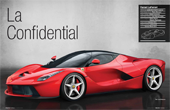 Vehicle type production/hybrid supercar
Vehicle type production/hybrid supercarFerrari design director Flavio Manzoni
Project manager Johann Lemercier
Lead interior designer Juan Manuel Lopez
Interior designers Edwin Osorio, Roberto Mastruzzo
Project started Summer 2010
Project completed Winter 2012
Launch Geneva/March 2013
The LaFerrari hybrid-electric supercar is the first project to be completed by Ferrari design director Flavio Manzoni’s newly established, in-house design team. Its development was long and challenging, and focused above all on reducing weight. “There’s inspiration from the frame and the suspension of Formula 1 [cars],” says Manzoni of these early sketches. “We have this idea in Italian: ‘telaistico’, or ‘frame-inspired’. The concept was to keep part of the frame of the dashboard visible. So that’s why there’s the transverse crossbeam gathering the air vents – visible and floating… it’s completely separated from the volume of the main dashboard.”
“Behind the ‘boomerang’ is a mesh which covers all the electronics,” reveals Manzoni. “It was necessary to let them [the electronics] breathe, and the idea of the mesh is nice because it gives the feeling of transparency and lightness.”
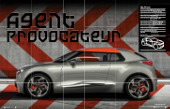 Vehicle type concept/hybrid-electric coupe
Vehicle type concept/hybrid-electric coupeChief design officer, Kia Peter Schreyer
Chief designer, Kia Europe Gregory Guillaume
Interior team leader Ralph Kluge
Interior designers Florent Mennechet/James Moon
Colour & trim manager Barbara Scheffler
Colour & trim designer Katharina Hirner
Project started Winter 2011
Project completed Autumn 2012
Launch Geneva/March 2013
Work began on the hybrid-electric Provo coupe concept at Kia’s Design Centre Europe in autumn 2011. The interior design began in earnest in January 2012, by which time exterior models had already been produced. An internal design competition led to French designer Florent Mennechet’s design being chosen for further clay model development.
Colour and trim manager Barbara Scheffler and C&T designer Katharina Hirner took a restrained approach to the Provo interior. “We wanted to use straightforward materials: polished aluminium, carbon-fibre [and] leather. In this respect, we were kind of on the safe side,” admits Kluge. “What we struggled with during the process was deciding how much bling we wanted… for example in the centre console gear selector and MMI. These are things you wouldn’t usually see in a hardcore sports car, so this [balance] is something that we spent some time fine-tuning.”
LEXUS IS
 Vehicle type production/executive sedan
Vehicle type production/executive sedanGeneral manager Yo Hiruta
Chief designer Tadashi Katagiri
Lead interior designer Yasuhiko Mizuhata
Colour and trim designer Maiko Watanabe
Project started Spring 2009
Project completed Winter 2012
Launch NAIAS Detroit/January 2013
TWork began on the third-generation IS sedan in Spring 2009. The interior design was influenced by the Lexus LFA’s three-dimensional cabin architecture, as illustrated by this final sketch. The instrument panel was given a cockpit-style look suited to sports driving, its horizontal layout reinforced from underneath by a console that sweeps dynamically towards the front.
A driver’s-eye view of the F-Sport production car’s interior. “The F-Sport version takes on more concrete LFA characteristics, such as an exclusive instrument cluster inheriting the LFA image, and wheels inheriting its design motifs,” reveals Katagiri. “The steering wheel shares design elements developed for the LFA; its circular padding makes it easier to get a sense of the centre of rotation.”
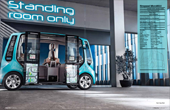 Vehicle type concept/urban people mover
Vehicle type concept/urban people moverProject leader Frank Rinderknecht
Interior designers Peter Kägi, Alain Brideson
Colour & trim design (Hornschuch) Johanna Axtmann & Ralf Imbery
Colour & trim design (Strähle + Hess) Udo Sawall & Julia Reinke
Project started July 2012
Project completed January 2013
Launch Geneva/March 2013
Rinspeed has been making an impact at the Geneva motorshow with its forward-thinking ‘what if’ concepts for more than 20 years. Its 2013 MicroMAX urban commuter concept was particularly interesting from an interior perspective because it started with the novel premise of a cabin designed for standing rather than sitting in, as these CAD drawings from the early stages of the project illustrate. Forklift truck expert, Linde, provided the electric powertrain housed within the vehicle’s chassis.
These photos of the MicroMAX show car reveal how much light the large windows, low beltline and unusual roof design let into the car’s interior. Its roof features four lightweight panes of PMMA plastic with a transparent, scratch-resistant coating – just a few microns thick - by KRD Sicherheitstechnik.
Wanting a quick and easy release system suitable for a vehicle such as the MicroMAX – which may need to pick up and drop off many people when used in a car-sharing club, for example – supplier TRW came up with a new prototype seatbelt on which the belt is looped around a metal ‘finger’. To lock the seatbelt in place, you simply push the finger downwards. Rinderknecht is a big fan: “It’s way better than trying to grab a sliding buckle and probably not finding the socket hole in the seat. This system is more simple, but would of course require a change in the current law to make production.”
Magazine
